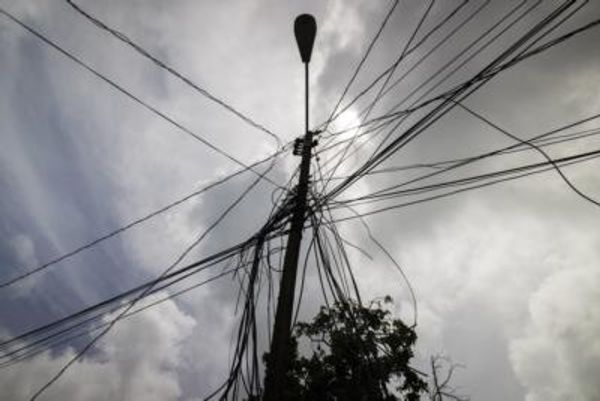
When President Biden appeared in Poland yesterday, he said that the Russian leadership could not remain in power if it continued to brutalize Ukraine. To this end, the global economic sanctions are meant to isolate President Putin not just from the civilized world but also from his people. What’s more likely is that Russia will get gradually elbowed out of the global energy supply chain.
Russia’s economy centers on the sale of oil and natural gas. The country is also a supplier of nuclear energy technologies and the uranium to run those power plants. Pulling the plug will be hard. But it can be jostled loose over a few years. The United States, Australia, and Qatar can supply natural gas while the Middle Eastern oil producers are always looking for new markets. Meantime, Australia, Canada, Nambia, and Niger can replace the uranium.
“The Russian invasion of Ukraine is a transformational turning point in global affairs, and the tectonic plates are shifting both economically and politically,” says Lori Esposito Murray, president of Economic Development for The Conference Board. “The world that emerges out of this crisis will be markedly different from the world order that preceded it. Even if Russia wins the Ukraine battle, it will lose the war because sanctions will not be lifted without a diplomatic resolution or regime change.”
Her comments came during a symposium sponsored by the United States Energy Association in which this journalist was a panelist. Murray went on to say that the economic sanctions — joined by 40 nations — are the harshest ever imposed: the value of the ruble has fallen precipitously, meaning no one wants to possess it because it can’t buy anything. The Russian stock market has been closed while its central bank has raised interest rates to 20%. Its economy will likely contract by 15% this year.
For example, Russian oil and gas sales make up 60% of its exports. The commodities are a quarter of its gross domestic product. Europe has relied on Russia for 39% of its natural gas. And those countries are now building liquefied natural gas terminals to ween themselves from Russian gas; the Nord Stream 2 natural gas pipeline will not get permitted unless Putin goes. Notably, Iran got cut out of the international banking system and subsequently lost about half of its oil export revenues and 30% of its foreign trade.
Deadly Decision

At the same time, Russia provides 20% of Europe’s uranium and 16% of this nation’s nuclear fuel. But the war in Ukraine has caused countries to question their relationship with Russia. Russia started supplying uranium shortly after the nuclear non-proliferation efforts of 1991-1993, which took uranium from bombs and channeled it to nuclear energy for peaceful purposes.
But Russia attacked two nuclear plants in Ukraine. One was Chernobyl, which was the site of the worst nuclear accident in history. And the other was Europe’s largest nuclear power plant. Ms. Murray says that President Putin was signaling that he was unafraid to escalate the war — to invoke the nuclear option. In her view, Putin acted to break the will of NATO, comprised of countries that experienced the fear of loose radiation in 1986.
But the sanctions are well underway, creating a worldwide ripple effect. “In the short term, the entire global energy sector will go through major disruptions, and major changes are going to come out of this,” says Murray. “In the long term, there are alternatives to the markets that Russia serves — whether that's nickel, oil, or gas, We will see those shifts. Russia has destroyed its reputation as a reliable supplier.”
“Australia and Canada will step up on uranium,” adds Clinton Vance, chair of the U.S. Energy Practice at Denton's law practice, during the conference. “These changes will not fulfill all of the needs, but they will be substantial. There will be a lot of disruption in the short term, but I think the markets will adjust in the intermediate-term.”
The war will not create a global recession — absent an escalation. However, the conflict underscores what some have been arguing for: the production of more U.S. shale oil and gas. In this country and Europe, natural gas prices have skyrocketed. “The world is so tight for energy that everything is needed,” Tellurian Chief Executive Charif Souki told this writer.
Consider: Tellurian will build an LNG production and export facility in Lake Charles, La. When the $20 billion “Driftwood” terminal is complete in five years, it will be capable of sending 28 million tons of LNG per year around the globe. The Bechtel Group is engineering the site, and next year, construction on the facility will start.
Green Energy May Hit Yellow Lights

One of the great lessons from this war is that the United States should strive to become energy independent, says Nick Akins, chair of American Electric Power, at the news event. The current conflict is the time for a gut check — about what it takes to maintain a reliable and secure energy network.
He advocates for an “all-of-the-above” energy strategy. Right now, coal is about half of AEP’s electricity mix. Since 2010, his company has sold or retired 13,500 megawatts of coal. It will shut down eight more coal plants by 2030 or 5,600 megawatts. AEP will replace much of that with renewables: 16,000 megawatts of regulated wind and solar through 2030. It already owns or operates more than 1,900 megawatts of renewable energy. The utility’s goal is to be net-zero by 2050.
“We need to ensure we are energy independent,” says Akins. “Suppliers are becoming more concerned about the risk of getting the raw materials in place. The lag times for new components are 6 times to 10 times longer. That part will catch up, but we can also work on these other technologies to further drive the clean energy economy.”
In the short run, the consensus is that the high price of natural gas will cause a surge in coal usage. That, in turn, will cause an increase in greenhouse gases. But that won’t last: most countries have set net-zero targets and have configured their policies to promote green energy usage — a trend that relies on the modern technologies made by the United States. As the world moves away from fossil fuels, the global dependency on Russia’s oil and natural gas also subsides.
However, green energy could get stalled by the war. That’s because Ukraine supplies about 50% of the world’s neon gas used to produce semiconductor chips. Ingas creates them out of Mariupol and Cryoin and Iceblick do so from Odessa. Two of those companies have ceased operations.
Solar arrays and wind turbines use those materials, which condition the power so that it can be fed into the transmission system. The chips also make the grid smarter, letting consumers adjust their energy usage while creating more room for green electrons. Further, semiconductors let utilities detect faults and prevent outages.
Demand has outstripped supply. But the good news is that semiconductor manufacturers are gearing up by diversifying their suppliers. Lead times, however, can be quite lengthy, even for established product lines.
It’s a threat. “Every aspect of our world is getting digitized,” says Peter Londa, chief executive of Tantalus Systems, during the program. “To do that, you need semiconductors. They have very granular data around energy consumption and power quality which utilities absolutely need.”
And cyberattacks are just as worrisome, he adds. “There’s an increased level of activity and threat — particularly from Russian IP-based addresses trying to impact the infrastructure.” Energy enterprises must therefore fortify and protect their assets.
Russia may be decimating Ukraine’s cities. But the war will destroy Russia’s economy. The West has no power to decide who rules Russia. But it can choose its energy providers: it is vowing to shed its dependence on Russian oil, gas, and uranium — contextualized by the fact that the globe is already trending green. While the realignment will cause economic pain in the West, it pales compared to what the Ukrainians have endured.







